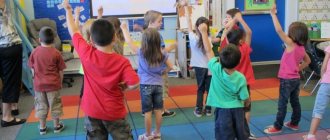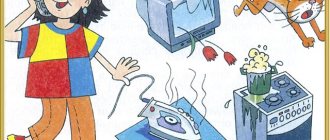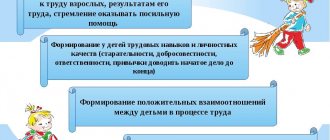The concept and essence of aesthetic education of preschool children
Definition 1
Aesthetic education is a purposeful process of influencing the personality of a preschool child, with the goal of developing his ability to see beauty in the world around him, works of art, as well as the ability to create beauty on his own.
Note 1
Aesthetic education of children must begin from the very first days of life.
Aesthetic education is a purposeful process of developing creative activity in preschool children, the ability to perceive and appreciate beauty in nature, life and art. Aesthetic education of preschool children includes instilling in children an aesthetic attitude towards social life, work, nature, art and everyday life. However, knowledge of works of art is very multifaceted, so it stands out as a separate part of the aesthetic education of children.
Are you an expert in this subject area? We invite you to become the author of the Directory Working Conditions
In the process of aesthetic education, preschool children become acquainted with the beauty in the surrounding life, nature and art, they learn to perceive and feel this beauty. This process contributes to the development of their imagination and imagination.
The system of aesthetic education for preschool children includes:
- education through artistic means;
- education through art;
- education through extra-artistic means (nature, work, environment, educational activities, etc.).
Note 2
Thus, the process of aesthetic education includes general cultural, philosophical and psychological-pedagogical education.
The purpose and objectives of aesthetic education of preschool children
The main goal of aesthetic education of preschool children is to give children the necessary knowledge, skills and abilities from various fields of art, as well as to develop their interest and desire to engage in independent creative activities.
Finished works on a similar topic
Course work Aesthetic education of preschool children 470 ₽ Abstract Aesthetic education of preschool children 280 ₽ Test work Aesthetic education of preschool children 240 ₽
Receive completed work or specialist advice on your educational project Find out the cost
Achieving the main goal of aesthetic education of preschool children is achieved through the consistent solution of a number of the following groups of tasks:
- The first group of tasks of aesthetic education are tasks aimed at developing in children an aesthetic attitude towards the world around them and their acquisition of theoretical knowledge. Includes a number of the following tasks:
- education of aesthetic culture in children;
the formation and development of aesthetic perceptions, feelings and experiences, as well as an aesthetic attitude towards the activities surrounding the child;
- developing in children the ability to see and feel beauty in actions, nature, art, and the world around them;
- cultivate the need for knowledge of beauty;
- nurturing the desire to surround yourself with beauty, to create it with your own hands.
- The second group of tasks of aesthetic education of preschool children is the formation in children of practical skills in the field of various types of arts. Includes:
- teaching children to sculpt, draw, design, sing, and move to music;
formation and development of oral creativity.
Aesthetic education of preschool children within the preschool educational institution involves solving the following problems:
- Carrying out the systematic development of the perception of beauty and aesthetic feelings of children, through various types of arts, activities, emotional involvement, etc.
- Introducing children to art, teaching them practical skills, educating them to bring elements of beauty into the environment as much as possible.
- Formation in children of aesthetic taste and the ability to independently evaluate works of art and life phenomena.
- Development of children's creative and artistic abilities through the organization of activities related to art.
Development of aesthetic feelings of preschool children through theatrical games
Dear friends, we are pleased to introduce you to Olga Vladimirovna Lysakova from the city of Alekseevka, Belgorod region . Today Olga Vladimirovna is pleased to bring to your attention the article “Development of aesthetic senses of preschoolers through theatrical games.” The article will be of interest to educators as well as parents.
A short commentary on the article from Olga Vladimirovna:
“By participating in theatrical activities, children get acquainted with the world around them through images, colors, sounds, and skillfully posed questions force children to think, analyze, draw conclusions and generalizations. The older children become, the higher the level of development, the more valuable theatrical play (pedagogically oriented) is for the development of amateur forms of behavior, where it becomes possible to outline the plot themselves or organize games with rules, find partners, and choose means to realize their plans.”
Fascinating reading...
Development of aesthetic feelings of preschoolers through
theatrical games
Theatrical play is one of the most democratic types of activities accessible to children; it allows solving current problems of pedagogy and psychology related to artistic and moral education, the development of personal communicative qualities, the development of memory, imagination, thinking, fantasy , initiative, etc.
At the same time, the developmental potential of theatrical play is currently underutilized, which can be explained by the presence of two contradictory trends in the methods of its organization.
According to the first trend, theatrical games are used mainly as a kind of “spectacle” at holidays. The desire to achieve good results forces teachers to memorize not only texts, but also intonations and movements with children during an unreasonably large number of individual and collective rehearsals. The child is trained to be a “good artist.” And, as a result, the spectacle took place, the audience liked the performance. However, the skills mastered in this way are not transferred by children to free play activities. Of course - after all, both the preparation for the performance and the performance itself are so different from the game!
The second trend in organizing theatrical play can be called non-interference by an adult. True, in practice it often develops into a complete lack of attention on his part to this type of play activity: children are left to their own devices, and the teacher is only preparing the attributes for the “theater”. The child is always accompanied by the same set of caps, masks, costume elements, and figurines of heroes...
Younger preschoolers are attracted to this, first of all, because of the opportunity to change clothes, and therefore to change, but the older preschooler is no longer satisfied with this, since it does not correspond to his cognitive interests, the level of development of mental processes, and increased opportunities for self-realization in creative activity. The consequence is the almost complete absence of theatricality in the play experience of children, even if they have an interest in this activity and a need for it.
Theatrical game-activity is unusually emotionally rich, which makes it attractive to children. It brings great joy and surprise to the child. It contains the origins of creativity; children accept the guidance of an adult without noticing it. Being a syncretic activity in nature, it most fully embraces the child’s personality and meets the specifics of the development of his mental processes: integrity and simultaneity of perception, ease of imagination and faith in transformations, emotional sensitivity, not only figurative, but also logical thinking, motor activity, etc. P. This indicates the broad developmental potential of theatrical play.
The results of the analysis of various points of view allow us to consider theatrical play as an activity subordinate to the plot-scenario and taking place within designated time and spatial boundaries. In the game, the adoption of an image is materialized (by dressing up or a doll) and is expressed through various symbolic means (facial expressions, pantomime, plastic arts, speech, singing, etc.).
The similarity between games and directing work is that the child himself comes up with the mise-en-scène, i.e. organizes the space, plays all the roles, or simply accompanies the game with an “announcer” text. The plot of any game can be represented as a sequence of interconnected situations, and in this sense it will be similar to the narrative text that underlies the theatrical game.
The purpose of educational activities is to create conditions for the development of aesthetic feelings in preschool children through theatrical activities using theatrical games.
The discovered contradiction between the developmental potential of theatrical play and its insufficient use in working with preschool children was a factor in the development of pedagogical technology and its testing in practice. The mutual influence of visual and theatrical play activities on the aesthetic education of children has been revealed: firstly, when decorating the scenery, and secondly, when images arise in children.
The relationship between these two types of artistic and aesthetic activities in the pedagogical process ensures:
- children’s assimilation of literary text as the fundamental basis of play-dramatization and plot depiction; accumulation and deepening of knowledge about the surrounding reality, and the use of skills to create images in the process of artistic activity, the emergence of new products - plot drawing and dramatization character;
- formation in artistic activity of a sense of form, rhythm, color, composition, expressive speech, movements;
- The development of an artistic and creative image in children goes through the following stages: the primary formation of the image on the basis of a literary work, enrichment, concretization of the image in a productive form understandable to others, its mutual enrichment due to the transfer of expressive means from one type of aesthetic activity to another.
One of the effective means of comprehensive development and education of a child in preschool age is theatrical games, which are close and understandable to both children and adults, primarily because it is based on play.
The significance and specificity of theatrical games lie in empathy, cognition, and the impact of the artistic image on the individual.
Theater is one of the most accessible forms of art for children, helping to solve many pressing problems of pedagogy and psychology related to:
- with art education and raising children;
- formation of aesthetic taste;
- moral education;
- development of personal communicative qualities;
- education of will, development of memory, imagination, initiative, fantasy, speech;
- creating a positive emotional mood, relieving tension, resolving conflict situations through play.
However, this type of activity contains great opportunities for solving a number of problems from different educational areas related to the speech, social, aesthetic, and cognitive development of the child, which are, to one degree or another, solved in the process of organized learning.
In the field of cognitive development:
- development of diverse ideas about reality;
- observation of natural phenomena and animal behavior;
- ensuring the relationship between design and theatrical play for the development of spatial concepts, creativity, and intellectual initiative;
- development of memory, anticipatory imagination, learning the ability to plan one’s actions to achieve results.
In the field of social development:
- formation of positive relationships between children in the process of joint activities;
- nurturing a culture of learning for adults and children;
- education of aesthetically valuable ways of communication in accordance with the norms and rules of life in society;
- development of emotions.
In the field of speech development:
- promoting the development of monologue and dialogic speech;
- enrichment of vocabulary, figurative expressions, comparisons, epithets, synonyms, antonyms;
- mastering expressive means of communication.
In the field of aesthetic development:
- introduction to fiction;
- the development of such forms of imagination, which are based on the interpretation of a literary image;
- involvement in joint design activities for modeling costume elements, scenery, and attributes;
- creating an expressive artistic image;
- development of spatial imagination as the basis for design thinking, creative design, predicting results;
- organization of collective work when creating multi-figure plot compositions;
- learning to independently find image techniques and materials
In the field of movement development:
- coordination of actions and accompanying speech;
- development of the ability to embody mood, character, and the process of image development in a creative movement;
- support for the development of musical-motor improvisation in etudes, expressive performance of basic types of movements.
In accordance with the set goals and objectives of pedagogical activity, I use both classical pedagogical forms, methods and means of teaching, as well as games and exercises from theater pedagogy, role-playing games, competitions and quizzes. The training is based on play activities, which corresponds to the age characteristics of children. Training sessions are inherently integrated in nature, and also involve the use of game forms of learning, finger and puppet theater, role-playing games, dramatization games and the embodiment of real situations. Types of classes are practical: game exercises, theatrical games, work on the expressiveness of speech when reading poetry, dramatization of fairy tales, etc. Classes are based on the principle of voluntary involvement in the game. Various types of games are used: emotional-sensory, intellectual, creative, active.
Acting training and a special series of exercises necessary for the general development of preschoolers are also used.
The optimal choice of means of educational work in accordance with the set goals is determined by the following approach: the means are closely related to techniques and methods and are used in unity with them. In defining the means, I proceed from the fact that the means include, on the one hand, various types of theatrical games, and on the other, a set of objects and works of artistic culture.
Theatrical classes perform simultaneously cognitive, educational and developmental functions and are in no way limited to preparing performances.
Games held in the classroom are really a game for the child, and not an organized activity, where each participant shows his initiative, his desires and ideas, learns to coordinate his actions with the actions of other participants, with certain rules
Classes with children in stage speech serve as a kind of standard for correct speech and at the same time exercise and develop their hearing and respiratory system. Consequently, by doing breathing exercises in the process of learning stage speech, the child simultaneously strengthens his health; trains the articulatory apparatus. This is extremely important because without the active skills of the articulatory apparatus established in childhood, an adult’s speech often becomes unclear and unintelligible. It does not convey to the listener the main component of speech - its content. All this may negatively affect his professional activities in the future.
Theatrical play can be divided into two groups: dramatization games and director's games. In dramatization games, the child independently creates an image using a set of expressive means (intonation, facial expressions, pantomime), performs his own actions in playing a role, performs any plot with a pre-existing script, which is not a rigid canon, but serves as a framework within which improvisation develops (acting out a plot without prior preparation). Children worry about their hero, act on his behalf, bringing their own personality to the character. That is why the hero played by one child will be completely different from the hero played by another. Dramatization games are performed without spectators or have the character of a concert performance. If they are performed in the usual theatrical form (stage, curtain, scenery, costumes, etc.) or in the form of a mass plot spectacle, they are called theatricalizations.
Types of dramatization:
- games that imitate images of animals, people, literary characters;
- role-playing dialogues based on text;
- staging of works;
- staging performances based on one or more works;
- Improvisation games where the plot is played out without prior preparation.
In director's play, the “artists” are toys or their substitutes, and the child, organizing the activity as a “scriptwriter and director,” controls the “artists.” “Voicing” the characters and commenting on the plot, he uses different means of verbal expression. The types of director's games are determined in accordance with the variety of theaters: tabletop, flat and volumetric, puppet (bibabo, finger, puppets), etc.
Director's games can be group games: everyone leads the toys in a common plot or acts as the director of an impromptu concert or play. At the same time, experience of communication, coordination of plans and plot actions is accumulated. In director's play, the child is not a stage character; he acts as a toy hero, acts as a screenwriter and director, and controls the toys or their substitutes.
Director's games are classified according to the variety of theaters (tabletop, flat, bibabo, finger, puppets, shadow, flannelgraph, etc.) Games can also be divided into two main groups: plot-role-playing (creative) and games with rules.
Role-playing games are games on everyday themes, with industrial themes, construction games, games with natural materials, theatrical games, fun games, and entertainment.
Games with rules include didactic games (games with objects and toys, verbal didactic, board-printed, musical and didactic games) and outdoor games (plot-based, plotless, with sports elements). In games with rules, attention should be paid to the combination of a fun challenge and active activity based on mental effort; this mobilizes the child’s intellectual potential.
Role-playing play is of great importance in the development of theatrical play in children. The peculiarity of theatrical play is that over time, children are no longer satisfied in their games only with the depiction of the activities of adults; they begin to be captivated by games inspired by literary works (on heroic, labor, historical themes). Children are more fascinated by the plot itself, its truthful portrayal, than by the expressiveness of the roles played. Thus, it is the plot-role-playing game that is a kind of springboard on which theatrical play receives its further development.
It is possible to divide theatrical games by means of depiction, depending on the leading methods of emotional expressiveness of the plot
and from artistic design to theatrical games, games with table theater, flannelgraph, shadow theater, Parsley theater, games with puppets]
The experience of organizing work on the development of aesthetic feelings in preschool children through systematization of means and methods of theatrical and play activities indicates significant changes:
- in the development of emotionality, intelligence, as well as communicative characteristics of preschool children;
- when building interpersonal relationships;
- in the development of communication skills;
- in understanding and assessing their emotional states and the states of their peers;
- in activating associative and figurative thinking;
- in the development of individual abilities;
- in mastering the expressiveness of speech, memory;
- in improving the artistic skills of preschoolers in terms of experiencing and embodying the image.
As a result of joint activities, children learned to notice interesting ideas in the world around them, embody them, create their own artistic image of a character, they developed creative imagination, associative thinking, and the ability to see the unusual in the ordinary.
Theatrical play is one of the brightest emotional means that shapes the artistic taste of children. The more diverse their impressions of the life around them, the richer their imagination, feelings, and ability to think.







